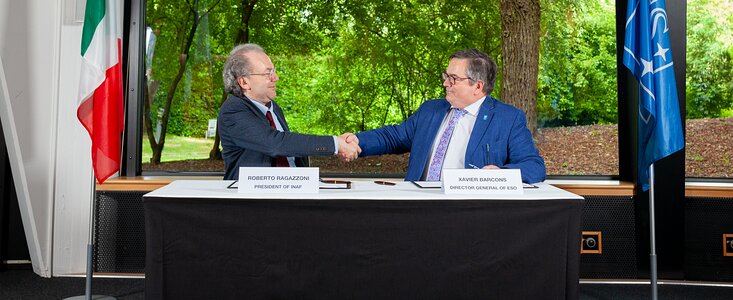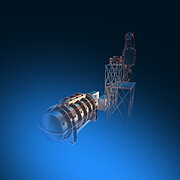Annonce
L'ESO signe un accord de construction pour l'instrument ANDES sur l'ELT
5 juin 2024
L'ESO a signé aujourd'hui un accord avec un consortium international d'institutions pour la conception et la construction d'ANDES, le spectrographe echelle à haute dispersion et à haute-précision (ArmazoNes high Dispersion Echelle Spectrograph). L'instrument ANDES sera installé sur l’Extremely Large Telescope (ELT) de l'ESO. Il sera utilisé pour rechercher des signes de vie sur les exoplanètes et les toutes premières étoiles, ainsi que pour tester les variations des constantes fondamentales de la physique et mesurer l'accélération de l'expansion de l'Univers.
L'accord a été signé par Xavier Barcons, directeur général de l'ESO, et par Roberto Ragazzoni, président de l'Institut national italien d'astrophysique (INAF), l'institution qui dirige le consortium ANDES. Sergio Maffettone, consul général d'Italie à Munich, et Alessandro Marconi, chercheur principal d'ANDES à l'INAF, ainsi que d'autres représentants de l'ESO, de l'INAF, du consortium ANDES et du consulat d'Italie à Munich, ont également assisté à la cérémonie de signature. La signature a eu lieu au siège de l'ESO à Garching, en Allemagne.
Anciennement connu sous le nom de HIRES, ANDES est un puissant spectrographe, un instrument qui décompose la lumière en ses différentes longueurs d'onde afin que les astronomes puissent déterminer des propriétés importantes des objets astronomiques, telles que leur composition chimique. L'instrument aura une précision record dans les longueurs d'onde du visible et du proche infrarouge et, associé au système de miroirs de l’ELT (un miroir primaire géant de 39m de diamètre généré par l’association de 798 hexagones d'une largeur de 1,40 mètres chacun), il ouvrira la voie à des recherches couvrant de multiples domaines de l'astronomie.
"ANDES est un instrument doté d'un énorme potentiel de découvertes scientifiques révolutionnaires, qui peuvent profondément affecter notre perception de l'Univers, bien au-delà de la petite communauté des scientifiques", a déclaré M. Marconi. Céline Péroux, responsable scientifique de l'équipe de l'ESO chargée du suivi d'ANDES, ajoute que les cas scientifiques vont "de la détection potentielle de signatures de vie dans d'autres mondes et de l'identification de la toute première génération d'étoiles, à l'étude des variations des constantes fondamentales de la physique".
ANDES effectuera des relevés détaillés de l'atmosphère des exoplanètes semblables à la Terre, ce qui permettra aux astronomes de rechercher des signes de vie à grande échelle. Il sera également en mesure d'analyser les éléments chimiques présents dans les objets lointains de l'Univers jeune, ce qui en fera probablement le premier instrument capable de détecter les signatures des étoiles de population III, les premières étoiles nées dans l'Univers. En outre, les astronomes pourront utiliser les données d'ANDES pour vérifier si les constantes fondamentales de la physique varient avec le temps et l'espace. Ses données complètes seront également utilisées pour mesurer directement l'accélération de l'expansion de l'Univers, l'un des mystères les plus pressants du cosmos.
L'ELT de l'ESO est actuellement en construction dans le désert d'Atacama, au nord du Chili. Lorsqu'il entrera en service à la fin de la décennie, l'ELT sera le plus grand observatoire du ciel au monde dans les longueurs d’onde visible au proche infra-rouge, marquant une nouvelle ère dans l'astronomie au sol.
Plus d'informations
Le projet ANDES est développé par un consortium international composé d'instituts de recherche de 13 pays :
● Allemagne: Leibniz-Institut für Astrophysik Potsdam (AIP), Institut für Astrophysik und Geophysik, Georg-August-Universität Göttingen (IAG), Atmospheric Physics of Exoplanets Department, Max-Planck-Institut für Astronomie Heidelberg (MPIA), Zentrum für Astronomie, Universität Heidelberg (ZAH), Thüringer Landesternwarte Tautenburg (TLS), Faculty of Mathematics, Informatics and Natural Sciences, Department of Physics, Hamburg Observatory, Universität Hamburg (UHH).
● Brésil: Board of Stellar Observational Astronomy, Universidade Federal do Rio Grande do Norte.
● Canada: Observatoire du Mont-Mégantic and the Trottier Institute for Research on Exoplanets, Université de Montréal.
● Danemark: Instrument Centre for Danish Astrophysics on behalf of Niels Bohr Institute, Aarhus University, Danmarks Tekniske Universitet.
● Espagne: Instituto de Astrofísica de Canarias (CI); Consejo Superior de Investigaciones Científicas (CSIC, Spain) on behalf of Instituto de Astrofísica de Andalucía (IAA), Centro de Astrobiología de Madrid (CSIC-INTA).
● France: Centre National de la Recherche Scientifique (CNRS) on behalf of Observatoire de la Côte d’Azur, Université Côte d’Azur (LAGRANGE), Laboratoire d’Astrophysique de Marseille, Aix-Marseille Université, Centre National d’Etudes Spatiales (LAM), Institut de Recherche en Astrophysique et Planetologie, Université Toulouse III-Paul Sabatier (IRAP), Institut de Planétologie et d’Astrophysique de Grenoble, Université Grenoble-Alpes (IPAG), Laboratoire Univers et Particules de Montpellier, Université de Montpellier (LUPM), Institut d’Astrophysique de Paris, Sorbonne Université (IAP), Laboratoire de Météorologie Dynamique, Ecole Normale Supérieure, Ecole Polytechnique, Sorbonne Université (LMD).
● Italie: INAF, Istituto Nazionale di Astrofisica (Lead Technical Institute).
● Pologne: Nicolaus Copernicus University in Torun.
● Portugal: Instituto de Astrofísica e Ciências do Espaço (IA) at Centro de Investigaço em Astronomia/Astrofísica da Universidade do Porto (CAUP), Instituto de Astrofísica e Ciências do Espaço at Faculdade de Ciências da Universidade de Lisboa, Board of the Associação para a Investigação e Desenvolvimento de Ciências (FCiências.ID)
● Royaume-Unis: Science and Technology Facilities Council, United Kingdom Research and Innovation on behalf of Cavendish Laboratory & Institute of Astronomy, University of Cambridge UK Astronomy Technology Centre; Institute of Photonics and Quantum Sciences, Heriot-Watt University.
● Suède: Lund University, Stockholm University, Uppsala University.
● Suisse: Département d’Astronomie, Université de Genève; Physikalische Institut, Universität Bern.
● USA: Department of Astronomy, University of Michigan
Liens
Contacts
Alessandro Marconi
ANDES Principal Investigator
Department of Physics and Astronomy, University of Florence, Italy
INAF-Arcetri Astrophysical Observatory, Italy
Email: alessandro.marconi@inaf.it, alessandro.marconi@unifi.it
Céline Péroux
ESO Project Scientist for ANDES
Email: cperoux@eso.org
Juan Carlos Muñoz Mateos
ESO Media Officer
Garching bei München, Germany
Tel: +49 89 3200 6176
Email: press@eso.org
À propos de l'annonce
| Identification: | ann24010 |
Our use of Cookies
We use cookies that are essential for accessing our websites and using our services. We also use cookies to analyse, measure and improve our websites’ performance, to enable content sharing via social media and to display media content hosted on third-party platforms.
ESO Cookies Policy
The European Organisation for Astronomical Research in the Southern Hemisphere (ESO) is the pre-eminent intergovernmental science and technology organisation in astronomy. It carries out an ambitious programme focused on the design, construction and operation of powerful ground-based observing facilities for astronomy.
This Cookies Policy is intended to provide clarity by outlining the cookies used on the ESO public websites, their functions, the options you have for controlling them, and the ways you can contact us for additional details.
What are cookies?
Cookies are small pieces of data stored on your device by websites you visit. They serve various purposes, such as remembering login credentials and preferences and enhance your browsing experience.
Categories of cookies we use
Essential cookies (always active): These cookies are strictly necessary for the proper functioning of our website. Without these cookies, the website cannot operate correctly, and certain services, such as logging in or accessing secure areas, may not be available; because they are essential for the website’s operation, they cannot be disabled.
Functional Cookies: These cookies enhance your browsing experience by enabling additional features and personalization, such as remembering your preferences and settings. While not strictly necessary for the website to function, they improve usability and convenience; these cookies are only placed if you provide your consent.
Analytics cookies: These cookies collect information about how visitors interact with our website, such as which pages are visited most often and how users navigate the site. This data helps us improve website performance, optimize content, and enhance the user experience; these cookies are only placed if you provide your consent. We use the following analytics cookies.
Matomo Cookies:
This website uses Matomo (formerly Piwik), an open source software which enables the statistical analysis of website visits. Matomo uses cookies (text files) which are saved on your computer and which allow us to analyze how you use our website. The website user information generated by the cookies will only be saved on the servers of our IT Department. We use this information to analyze www.eso.org visits and to prepare reports on website activities. These data will not be disclosed to third parties.
On behalf of ESO, Matomo will use this information for the purpose of evaluating your use of the website, compiling reports on website activity and providing other services relating to website activity and internet usage.
Matomo cookies settings:
Additional Third-party cookies on ESO websites: some of our pages display content from external providers, e.g. YouTube.
Such third-party services are outside of ESO control and may, at any time, change their terms of service, use of cookies, etc.
YouTube: Some videos on the ESO website are embedded from ESO’s official YouTube channel. We have enabled YouTube’s privacy-enhanced mode, meaning that no cookies are set unless the user actively clicks on the video to play it. Additionally, in this mode, YouTube does not store any personally identifiable cookie data for embedded video playbacks. For more details, please refer to YouTube’s embedding videos information page.
Cookies can also be classified based on the following elements.
Regarding the domain, there are:
- First-party cookies, set by the website you are currently visiting. They are stored by the same domain that you are browsing and are used to enhance your experience on that site;
- Third-party cookies, set by a domain other than the one you are currently visiting.
As for their duration, cookies can be:
- Browser-session cookies, which are deleted when the user closes the browser;
- Stored cookies, which stay on the user's device for a predetermined period of time.
How to manage cookies
Cookie settings: You can modify your cookie choices for the ESO webpages at any time by clicking on the link Cookie settings at the bottom of any page.
In your browser: If you wish to delete cookies or instruct your browser to delete or block cookies by default, please visit the help pages of your browser:
Please be aware that if you delete or decline cookies, certain functionalities of our website may be not be available and your browsing experience may be affected.
You can set most browsers to prevent any cookies being placed on your device, but you may then have to manually adjust some preferences every time you visit a site/page. And some services and functionalities may not work properly at all (e.g. profile logging-in, shop check out).
Updates to the ESO Cookies Policy
The ESO Cookies Policy may be subject to future updates, which will be made available on this page.
Additional information
For any queries related to cookies, please contact: pdprATesoDOTorg.
As ESO public webpages are managed by our Department of Communication, your questions will be dealt with the support of the said Department.


